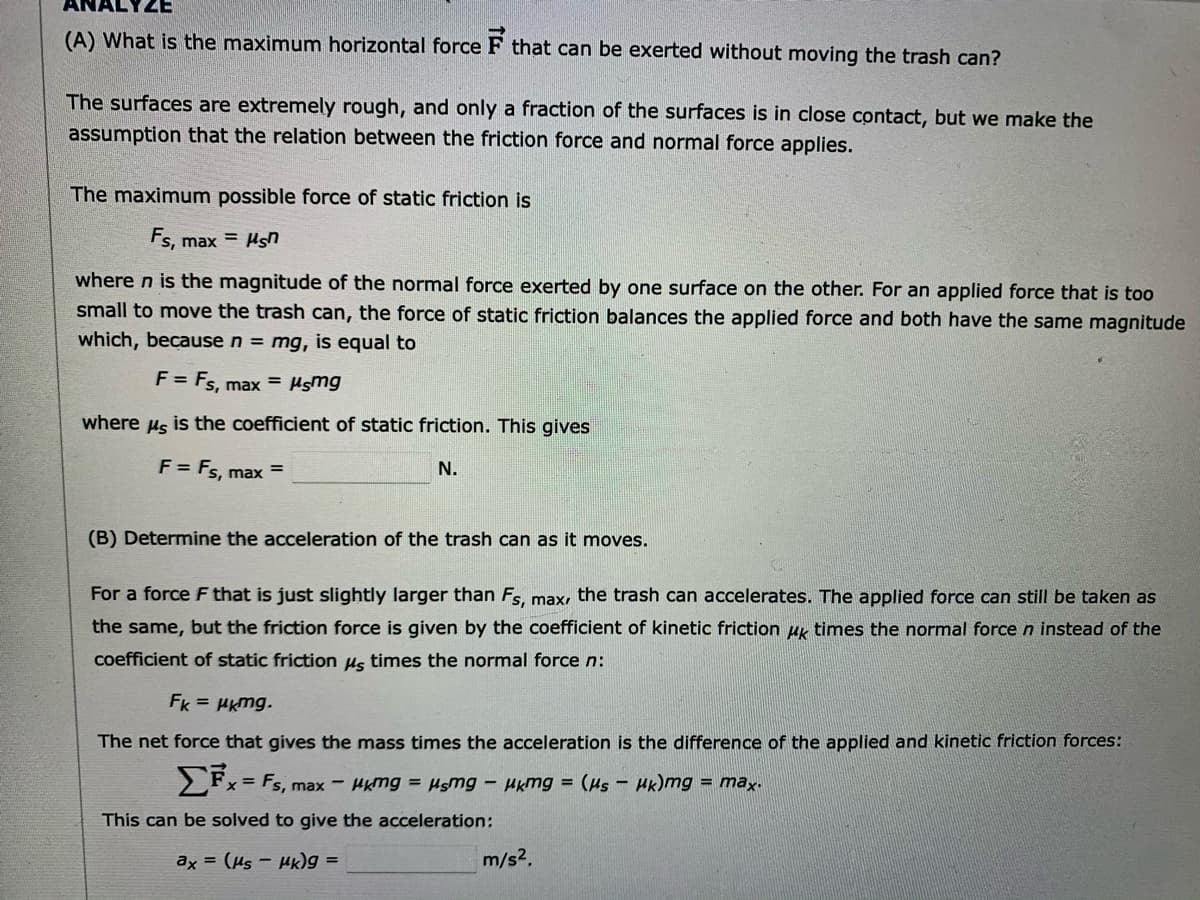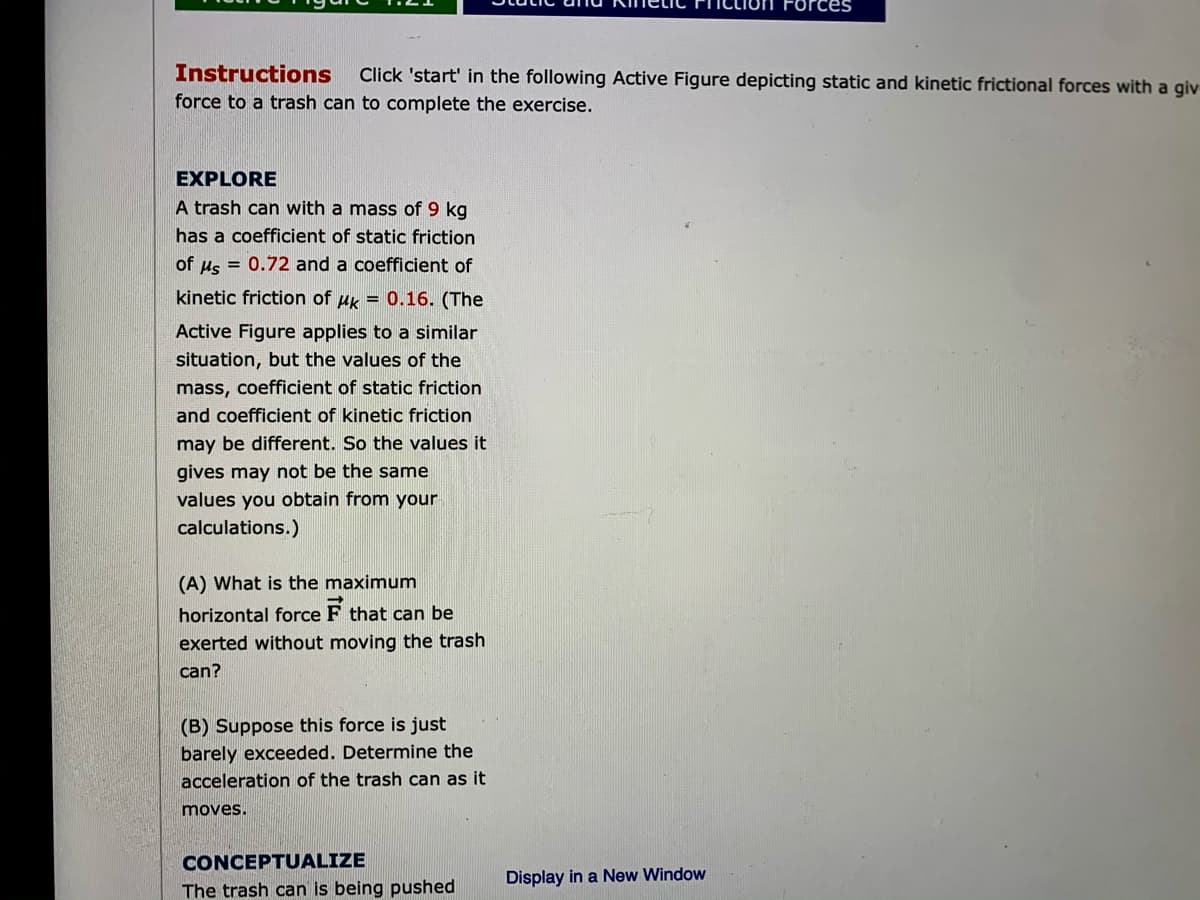EXPLORE A trash can with a mass of 9 kg has a coefficient of static friction of us = 0.72 and a coefficient of kinetic friction of uk = 0.16. (The %3D Active Figure applies to a similar situation, but the values of the mass, coefficient of static friction and coefficient of kinetic friction may be different. So the values it gives may not be the same values you obtain from your calculations.) (A) What is the maximum horizontal force F that can be exerted without moving the trash can? (B) Suppose this force is just barely exceeded. Determine the acceleration of the trash can as it moves.
EXPLORE A trash can with a mass of 9 kg has a coefficient of static friction of us = 0.72 and a coefficient of kinetic friction of uk = 0.16. (The %3D Active Figure applies to a similar situation, but the values of the mass, coefficient of static friction and coefficient of kinetic friction may be different. So the values it gives may not be the same values you obtain from your calculations.) (A) What is the maximum horizontal force F that can be exerted without moving the trash can? (B) Suppose this force is just barely exceeded. Determine the acceleration of the trash can as it moves.
University Physics Volume 1
18th Edition
ISBN:9781938168277
Author:William Moebs, Samuel J. Ling, Jeff Sanny
Publisher:William Moebs, Samuel J. Ling, Jeff Sanny
Chapter6: Applications Of Newton's Laws
Section: Chapter Questions
Problem 58P: Calculate the maximum acceleration of a car that is heading up a 4.00slope (one that makes an angle...
Related questions
Topic Video
Question
Please answer all questions based on the scenario.

Transcribed Image Text:ANA
ZE
(A) What is the maximum horizontal force F that can be exerted without moving the trash can?
The surfaces are extremely rough, and only a fraction of the surfaces is in close contact, but we make the
assumption that the relation between the friction force and normal force applies.
The maximum possible force of static friction is
Fs, max = Hsn
where n is the magnitude of the normal force exerted by one surface on the other. For an applied force that is too
small to move the trash can, the force of static friction balances the applied force and both have the same magnitude
which, because n = mg, is equal to
F = Fs, max = Hsmg
where us is the coefficient of static friction. This gives
F = Fs, max
N.
(B) Determine the acceleration of the trash can as it moves.
For a force F that is just slightly larger than Fs, max, the trash can accelerates. The applied force can still be taken as
the same, but the friction force is given by the coefficient of kinetic friction ug times the normal force n instead of the
coefficient of static friction Hs times the normal force n:
Fk = Hkmg.
The net force that gives the mass times the acceleration is the difference of the applied and kinetic friction forces:
x= Fs, max - HKmg = Hsmg – Hkmg = (Hs - Hk)mg = max.
This can be solved to give the acceleration:
ax = (µs - HK)g =
m/s2.

Transcribed Image Text:rces
Instructions
Click 'start' in the following Active Figure depicting static and kinetic frictional forces with a giv
force to a trash can to complete the exercise.
EXPLORE
A trash can with a mass of 9 kg
has a coefficient of static friction
of us = 0.72 and a coefficient of
kinetic friction of uk = 0.16. (The
Active Figure applies to a similar
situation, but the values of the
mass, coefficient of static friction
and coefficient of kinetic friction
may be different. So the values it
gives may not be the same
values you obtain from your
calculations.)
(A) What is the maximum
horizontal force F that can be
exerted without moving the trash
can?
(B) Suppose this force is just
barely exceeded. Determine the
acceleration of the trash can as it
moves.
CONCEPTUALIZE
Display in a New Window
The trash can is being pushed
Expert Solution
This question has been solved!
Explore an expertly crafted, step-by-step solution for a thorough understanding of key concepts.
This is a popular solution!
Trending now
This is a popular solution!
Step by step
Solved in 3 steps with 2 images

Knowledge Booster
Learn more about
Need a deep-dive on the concept behind this application? Look no further. Learn more about this topic, physics and related others by exploring similar questions and additional content below.Recommended textbooks for you

University Physics Volume 1
Physics
ISBN:
9781938168277
Author:
William Moebs, Samuel J. Ling, Jeff Sanny
Publisher:
OpenStax - Rice University

Glencoe Physics: Principles and Problems, Student…
Physics
ISBN:
9780078807213
Author:
Paul W. Zitzewitz
Publisher:
Glencoe/McGraw-Hill

University Physics Volume 1
Physics
ISBN:
9781938168277
Author:
William Moebs, Samuel J. Ling, Jeff Sanny
Publisher:
OpenStax - Rice University

Glencoe Physics: Principles and Problems, Student…
Physics
ISBN:
9780078807213
Author:
Paul W. Zitzewitz
Publisher:
Glencoe/McGraw-Hill